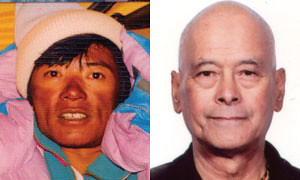After a decade of struggle and perseverance, the Nepal National Mountain Guide Association (
NNMGA) has finally been certified by the International Federation of Mountain Guide Associations (
IFMGA).
What makes this award special is that Nepal is the only other country in Asia besides Japan to be recognised by the IFMGA and it means our mountaineering guides are now part of an elite rank and can display skills and expertise from the Alps to the Andes and the Himalaya.
The journey to the top took more than three decades. In 1982, guides Tashi Jangbu Sherpa, Jimpa Jangbu Sherpa, and Padam Ghale became the first Nepali guides to receive instructor training at Chamonix in the French Alps. Ghale along with former and current directors of NNMGA, the late Iman Gurung, Pemba Gyalje Sherpa, and member Prem Gurung have been at the forefront of improving guiding standards.

Iman Singh Gurung, Padam Ghale
The Nepal Mountaineering Association (
NMA) started in 1973, too, played a key role. For the last 20 years it has been offering basic and advanced training courses producing a pool of well-qualified, professional Nepali mountaineers.
However, politicisation and over-commercialisation have tarnished the institution’s value. Enrolling trainees based on political influence or bribes instead of ability has become common practice. But now that climbers can get certified directly through IFMGA, this will hopefully push NMA to become a more professional organisation on par with European and other counterparts.
A group of Nepali guides who received trainee diplomas from IFMGA in 2006 completed their final round of examinations in the Annapurna region last May. They were tested in ice and rock climbing, mountain medicine, meteorology, and rescue. This pioneer group was awarded certificates recently at a function at Shanker Hotel and NNMGA was formally welcomed to the international fold.

Prem Gurung, Pemba Sherpa
The final push for IFMGA membership came from an unexpected quarter: Chief Secretary Lila Mani Poudel got a first-hand understanding of the challenges faced by Nepal’s mountain guides when he led a team of 15 government employees on an Everest expedition in 2011.
For far too long Nepali guides have been regarded with suspicion and used only as porters or helpers on foreign-led expeditions. However, experience shows that they are better at acclimatisation, can carry heavier loads, identify alternative routes, and lead rescue efforts as well as their Western counterparts. They have even conquered technical peaks like Ama Dablam.
Full membership of IFMGA means new avenues for mountaineering in Nepal will open up, providing jobs to thousands. Most importantly, people across the country will be encouraged to take up climbing as a profession. Nepali mountaineering has finally arrived.
www.nnmga.org.np
www.nepalmountaineering.org
www.ivbv.info
See also:
Nepali women climbers set the pace
Trained to climb
Way to the top